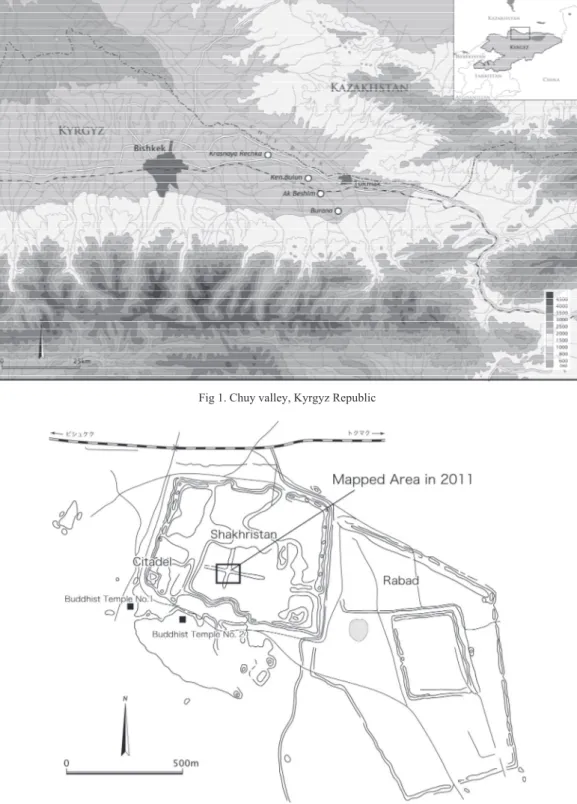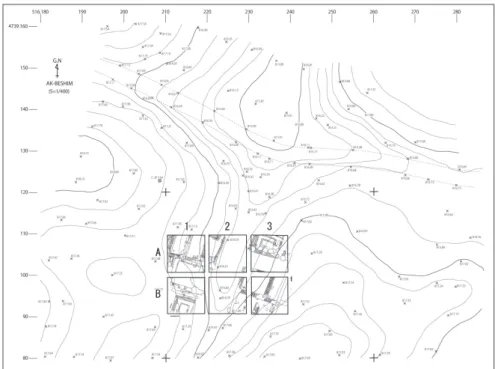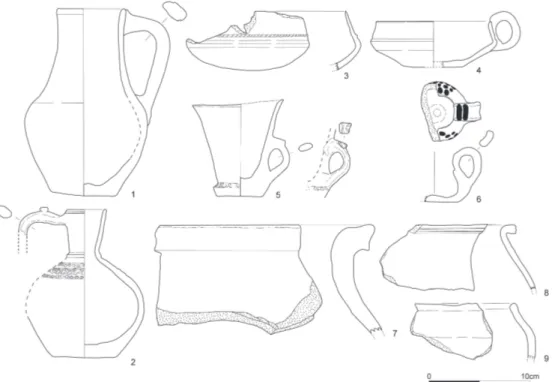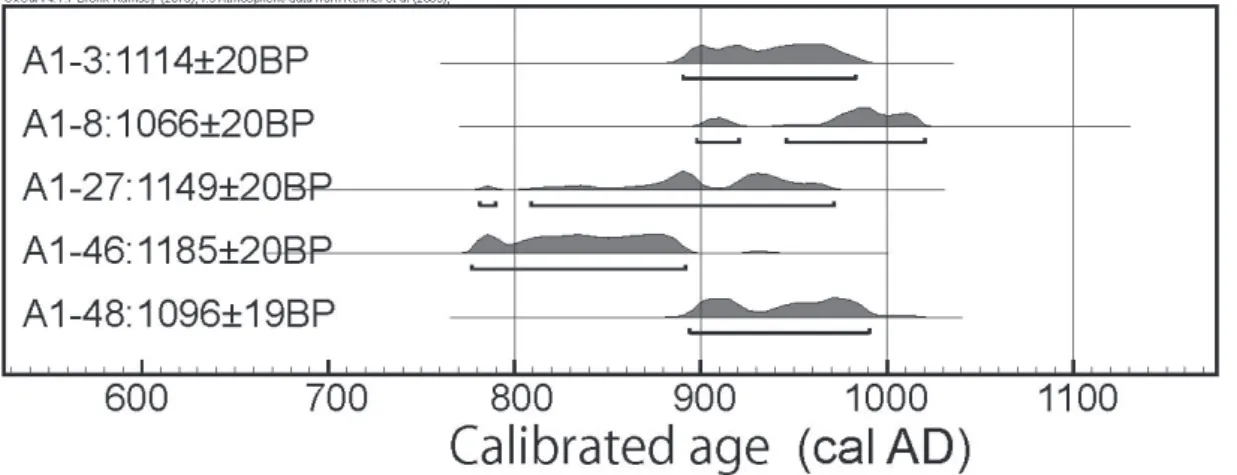Results of the Archaeological Project at Ak Beshim (Suyab), Kyrgyz
Republic from 2011 to 2013 and a Note on the Site`s Abandonment
Masashi Abe
11 The National Research Institute for Cultural Properties, Tokyo, Tokyo, Japan
Corresponding author: Masashi Abe, the National Research Institute for Cultural Properties, Tokyo, 13-43 Ueno Park, Taito-ku, Tokyo, 110-8713, Japan, E-mail: abe@tobunken.go.jp
Keywords: Ak Beshim, Suyab, Kyrgyz, Qara Khan Dynasty, Radiocarbon dating, Excavations
Abstract: The National Research Institute for Cultural Properties, Tokyo has been conducting an archaeological project at Ak
Beshim (Suyab) in the Chuy Valley, Kyrgyz Republic since 2011. This paper provides preliminary results of the project`s first three seasons from 2011 to 2013. The excavations revealed a Qarakhanid main street and several houses along the street in the center of
Shakhrsitan of Ak Beshim. This layer is dated by radiocarbon to the late 10th century. According to historical documents, the region
was Islamized in the middle of the 10th century, so this layer provides relevant cultural materials for studying Islamization in this region. Radiocarbon dating also suggests that Ak Beshim was abandoned in the late 10th century, 200 years earlier than previously believed. Reasons behind the abandonment of Ak Beshim are considered at the end of this paper.
1. Introduction
The National Research Institute for Cultural Properties, Tokyo (hereafter NRICPT) has been conducting an archaeological project at the site of Ak Beshim (ancient name: Suyab) in the Chuy Valley, Kyrgyz Republic jointly with the Institute of History and Cultural Heritage of the National Academy of Sciences, Kyrgyz Republic and the Nara National Research Institute for Cultural Properties (hereafter NNRICP) since 2011 (Yamauchi et al. 2012, 2013, 2014). This project is funded by the UNESCO/Japan Funds-in-Trust Project, ‘Support for Documentation Standards and Procedures of the Silk Roads World Heritage Serial Transnational Nomination in Central Asia’ as well as ‘Networking Core Centers for International Cooperation on Conservation of Cultural Heritage Project: Training Workshop for the Protection of Cultural Heritage in Central Asia’ from the Agency for Cultural Affairs, Japan.
This paper has two goals. The first is to publish preliminary results of the first three seasons of the project from 2011 to 2013 at Ak Beshim. Results of the excavations suggest that Ak Beshim was abandoned in the late 10th century, 200 years earlier than previously believed. The second goal is to consider reasons for the settlement’s abandonment.
2. The Site of Ak Beshim (Suyab)
The Chuy Valley is located in the northern Kyrgyz Republic and measures 80 by 200 km (Fig. 1). The basin is surrounded by the Ala-too Mountains in the south and the Chuy-Ili Mountains in the northeast. The Chuy River, which originates from mountain
glaciers, runs from east to west in the center of the valley. Annual precipitation in the valley varies from 270 to 400 mm. Thus, the basin has flourished as an agricultural region since ancient times. The Chuy Valley was a part of the Tian-Shan corridor of the Silk Roads, with over 20 remains of medieval fortified towns there (Kenjeahmet 2009).
The archaeological project at Ak Beshim started in 2011. In 2011, topographical mapping and surface collection of archaeological objects were undertaken. Over the next two seasons in 2012 and 2013, excavations were undertaken at the central part of the Shakhristan of Ak Beshim.
The site of Ak Beshim is situated in the eastern part of the Chuy Valley and located 45 km east of Bishkek, the modern capital of the Kyrgyz Republic (Fig. 1). Ak Beshim is also identified as Suyab, which is mentioned in Chinese literature.
The history of Ak Beshim (Suyab) probably goes back to the 5th century. At that time, many settlements were founded by Sogdian immigrants from the west and it is generally believed that the site was also founded by these groups. Since then, the settlement grew into a center along the Tian-Shan corridor of the Silk Roads (Kenjeahmet 2009).
In the 7th century, Ak Beshim became a political center of the Western Turkic Khaganate. Suyab is mentioned in the famous Chinese text, Da Tang Xiyu Ji (Great Tang Records on the Western regions) by Xuanzang. According to the text, Xuanzang, a Chinese monk, stopped over at Suyab on the way to India and met Yabghu Qaghan, a qaghan of the Western Turkic Khaganate. It is also argued that Li Po, a famous Chinese poet, was born in Suyab (Saito 2011).
Soon after Xuanzang left Suyab, the Tang Dynasty in China sent armies to Central Asia and attacked the Western Turkic Khaganate. One of the main Tang military bases called Suyab
Zhen was placed at Suyab. The Tang and Western Turkic
Khagante battled over Suyab many times.
Even after Tang left Suyab, it continued to be a main political center of the Qarluq and Qara Khan Dynasties. The latter is the first Turkic Islamic dynasty in Central Asia. It is well known that the Qara Khan Dynasty waged the Holy War against Buddhist states such as Hotan and Kuqa in the Tarim Basin (Maruyama 2008; Kenjeahmet 2009).
3. Archaeological Project at the Site of Ak Beshim
Ak Beshim consists of three parts: Citadel, Shakhristan and
Rabad(Fig. 2). The size of the Shakhristan is approximately 35 ha and the Citadel, which was the palace of the governor, was located at its south-western corner. The Rabad is located southeast of the Shakhristan and reaches over 60 ha in size. In addition, Ak Beshim is protected by 11 km long earthen walls (Kenjeahmet 2009).
Ak Beshim was first researched by V. V. Bartold at the end of the 19th century. Since then, the site was investigated mainly
Fig 1. Chuy valley, Kyrgyz Republic
Results of the Archaeological Project at Ak Beshim (Suyab), Kyrgyz Republic from 2011 to 2013 and a Note on the Site`s Abandonment
by Russian and Kyrgyz archaeologists. However, most of their excavations focussed on large mounds, representing remains of monumental buildings such as the palace, Nestorian church, and Buddhist temples.
In contrast, residential areas had only been limitedly excavated in the past (Amanbaeva, Kolchenko, and Satev 2013). Therefore, a number of archaeological questions about the ordinary occupants of the site remain unsolved. Therefore,
NRICPT decided to excavate a residential area. So six excavation squares (A1, A2, A3, B1, B2, B3) measuring 20 m x 30 m overall were set up in the center of the Shakhristan (Figs. 2 and 3). The squares were excavated over two seasons in 2012 and 2013.
A Qarakhanid main street, that runs from north to south, two alleys and several houses along the street were excavated from the top layer (Fig. 4). As will be discussed in detail below, this
Fig 3. The Central Part of Shakhristan and Excavation Squares
top layer is dated to the late 10th century (Fig. 7).
The Qara Khan Dynasty was the first Turkish Islamic dynasty in Central Asia. According to historical documents, Islam rapidly spread over the realm of the Qara Kkan Dynasty in the middle of the 10th century after the conversion of Satok Bogura Khan (Maruyama 2008).
Therefore, this top layer was created during Islamization period in this region and can provide very important materials for studying this process in the eastern parts of Central Asia. 3.1. ARCHITECTURE
During the excavations, several houses were uncovered. These were probably houses belonging to the ordinary people rather than the mansions of rich people. Two seasons of excavations revealed basic characteristics of these Qarakhanid houses, as described below (Fig 4).
i) The house often consists of two rooms: a main room and subsidiary room. The main room measures 3.5-5.0 m x 4.0-5.5 m. Some main rooms have benches (Sufa) along the walls. Given that no staircases were discovered during the excavation and the
walls are narrow, it is likely that the house had only one floor. Despite a lack of supporting evidence, it appears that the roof was probably flat.
ii) The main room often has a subsidiary room. In that case, the main room is usually on the main street. The subsidiary room is narrow and measures 1.5-3 m x 5.0-6.5 m. The subsidiary room is often equipped with ovens, indicating that they were probably used as kitchens. Whether the subsidiary room had a roof remains unknown.
iii) In Square A3, the house`s entrance was excavated in the house. The entrance was open to a small street rather than the main street. To enter the main room, the inhabitants had to pass through the subsidiary room.
3.2. POTTERY
The excavations yielded a number of Qarakhanid pottery. The pottery varies in shape including cooking pots, large, medium, and small sized jars, bowls, cups with a handle and so on. Several fragments of Islamic glazed ware were also excavated (Fig. 5).
Fig 5. Qarakhanid Pottery Excavated from Ak Beshim (Drawing: Shogo KUME)
Results of the Archaeological Project at Ak Beshim (Suyab), Kyrgyz Republic from 2011 to 2013 and a Note on the Site`s Abandonment
One pottery shard is particularly noteworthy (Fig. 6). On the shard, the Islamic phrase, ‘There is no god except Allah. Muhammad is the messenger of Allah’ is inscribed. The text was apparently inscribed on the pottery before firing. So it is likely that the pottery maker inscribed this Islamic phrase. This suggests that Islam spread among not only elites but also ordinary people such as pottery makers in the late 10th century. Before this example, such pottery shards had not been discovered in the Kyrgyz Republic.
3.3. OTHER FINDINGS
Several metal objects were also excavated. These include Qara Khan coins, Turgesh coins, iron scales from an armour, iron knives, iron awls, an iron decoration plaque from a leather belt, and bronze rings.
Several clay objects were found, including animal figurines and spindle whorls. Some ornaments such as pierced pearls and carnelian beads were also discovered.
The excavated animal bones and retrieved botanical samples are still under study. Results will be published in future.
4. Results of Radiocarbon Dating and the Decline of Ak Beshim
This session provides results of the new radiocarbon dating series and explains its significance. The reasons for the decline of Ak Beshim will then be considered.
Before our excavations, it was generally argued that Ak Beshim was abandoned in the 12th century or the beginning of the 13th century (Kenjeahmet 2009).
However, the new excavations by NRICPT contradict this theory. As mentioned above, the top layer of the central part of the Shakhristan is dated to the late 10th century (Fig. 7). This strongly suggests that at least the central part of Ak Beshim was probably abandoned in the late 10th century or the beginning of the 11th century at the latest, 200 years earlier than previously believed. These data imply that Ak Beshim (Suyab) was abandoned when the region was Islamized.
In contrast, Burana (ancient name: Balasagun) continuously flourished after the late 10th century. The new capital of the Qara Khan Dynasty, Burana was founded in the early 10th century. The site is located just 5 km south of Ak Beshim. A high Islamic
minaret stands in the center of Burana today. This minaret is one
of the oldest minarets in Central Asia and is argued to have been constructed in the late 10th century (Amanbaeva, Kolchenko and Sataev 2013). A great mosque was probably constructed together
with the minaret in Burana although the mosque remains unexcavated. This suggests that Ak Beshim was abandoned when Burana was transformed into an Islamic town with its minaret and great mosque. No remains of Islamic minarets and mosques were known at Ak Beshim.
There are probably many factors behind the abandonment of Ak Beshim, but the main ones were political and economic. Ak Beshim lost its central position in the economy and politics when Burana was founded as the new capital of Qara Khan Dynasty in the early 10th century. This is a primary reason why the inhabitants of Ak Beshim left the site.
In addition, religious factors were probably also significant. Islam spread across this region after the mid 10th century. However, the old town of Ak Beshim likely had many problems in transforming the town into an Islamic city. Because the town was founded in the 5th century, there was likely too little space to construct a minaret and mosque in the center of this highly crowded place. The newly founded town of Burana, which was probably less crowded with buildings, was more suitable for becoming an Islamic center. Islamic monuments were constructed by the Qara Khan Dynasty mainly at Burana rather than Ak Beshim, which probably encouraged the decline of Ak Beshim.
Acknowledgements
I would like to thank Dr. Djenish Djunushaliev, Dr. Bakit Amanbaeva, Dr. Valery Kolchenko, and Dr. Aidai Sulaimanova of the Institute of History and Cultural Heritage, National Academy of Sciences, Kyrgyz Republic for their help with our project at Ak Beshim.
References
&
Amanbaeva, B., Kolchenko, V.A. Sataev, K.A. (2013) Kyrgyzstan. In Baypakov, K., Pidaev, Sh Muradov, R. (eds.), The Artistic Culture &
of Central Asia and Azerbaijan in the 9th-15th Centuries Volume IV: Architecture. Samarkand, International Institute for Central Asian
Studies.
Kenjeahmet, N. (2009) Archaeology of Suyab. In Kubota, J., &
Kicengge Inoue, M (eds.), Historical and Geographical Essays on
Ili Valley, 217-301. Kyoto, Shokado (in Japanese).
Maruyama, K. (2008) Qara Khan Dynasty and the Inflow of Islam into Xinjiang. Journal of the Faculty of International Studies Bunkyo
University 18/2, 51-66 (in Japanese).
Saito, S. (2011) Suyab and Ak Beshim. Paper Presented at the Seminar,
Archaeological Sites in the Chuy Valley, Kyrgyz Republic. January
14, 2011, National Research Institute for Cultural Properties, Tokyo (in Japanese).



